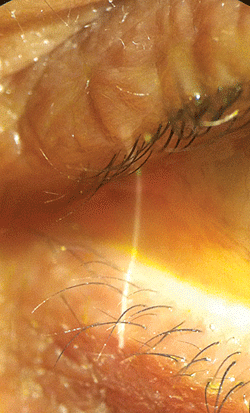 History
History
A 57-year-old white female presented with a chief complaint of excessive tearing in her left eye. She reported that the tears were running overtop of her lower lid for approximately three months. Her systemic and ocular histories were unremarkable, and she denied exposure to chemicals or allergens of any kind.
Diagnostic Data
Best-corrected entering visual acuity measured 20/20 O.U. at distance and near. Her external examination was normal, with no evidence of afferent pupillary defect. Goldmann applanation tonometry measured 15mm Hg O.U.
The dilated fundus findings were normal––both peripherally and centrally––with healthy nerves and maculae O.U. The biomicroscopic examination of the anterior segment is illustrated in the photograph.
Your Diagnosis
How would you approach this case? Does this patient require any additional tests? What is your diagnosis? How would you manage this patient? What’s the likely prognosis?
Thanks to Todd R. Dimmick, O.D., of Philadelphia and Marc Otto, B.S., a fourth-year optometry student at Salus University in Elkins Park, Pa., for contributing to this case.
Discussion
Additional testing included an examination of the eyelids for blepharitis, dystachiasis or trichiasis. Also, we performed sodium fluorescein staining to assess the status of the corneal epithelium. A cotton-tipped applicator was used to probe the area and retract conjunctival tissues.
The diagnosis in this case is epiphora secondary to conjunctivochalasis (O.S. > O.D.).1-5 Conjunctivochalasis is defined as the presence of excessive and loose conjunctival tissue located between the ocular globe and lid margin. This presentation often yields varying pathophysiologic consequences.1-5 In our patient, the conjunctival tissue covered both puncta, which obstructed tear drainage.
Conjunctivochalasis is an age-related condition that generally is dismissed as a normal, senile change because it rarely produces ocular symptoms or requires intervention.1 Epiphora is the primary symptom of moderate and/or severe conjunctivochalasis, because additional tissue often folds over the lower lid and/or occludes the puncta.2 Less commonly, patients manifest symptoms that mimic those caused by dry eye syndrome, including general ocular irritation.3

Biomicroscopic view of our 57-year-old patient’s left eye. What do you notice?
As age increases, so does the prevalence of conjunctivochalasis. The condition is rare in individuals age one year to 10 years.4 However, its prevalence increases to 70% in individuals ages 30 to 40 years. Further, nearly 100% of patients 90 years of age or older exhibit some degree of conjunctivochalasis.4
The existence of conjunctivochalasis can be subtle. Initially, patients with epiphora often are thought to have ocular surface disease and are subjected to multiple lacrimal draining procedures. This is why it’s essential for the eye care clinician to examine the punctum carefully for the presence of obstructive tissue.5
Conventional treatment includes a conjunctivoplasty—surgical excision of the excess conjunctiva from the eye.6 Alternatively, a fibrin sealant injection may be administered into the subconjunctival space prior to surgical intervention. The fibrin injection pinches the excess tissue before cutting, which permits the remaining conjunctiva to settle back onto the globe with fewer complications.7 Also, it is possible to use an argon laser to make the incision and remove unwanted tissue.8
Our patient underwent uncomplicated surgical excision to remove the excess tissue. The procedure curtailed her epiphora, and was contented with the postoperative result.
1. Meller D, Tseng S. Conjunctivochalasis: literature review and possible pathophysiology. Surv Ophthalmol. 1998 Nov-Dec;43(3):225-32
2. Liu D. Conjunctivochalasis. A cause of tearing and its management. Ophthal Plast Reconstr Surg. 1986;2(1):25-8.
3. Yokoi N, Komuro A, Nishii M, et al. Clinical impact of conjunctivochalasis on the ocular surface. Cornea. 2005 Nov;24(8 Suppl):S24-S31.
4. Mimura T et al. Changes of conjunctivochalasis with age in a hospital-based study. Am J Ophthalmol. 2009 Jan;147(1):171-7.e1.
5. Georgiadis NS, Terzidou CD. Epiphora caused by conjunctivochalasis: treatment with transplantation of preserved human amniotic membrane. Cornea. 2001 Aug;20(6):619-21.
6. Serrano F, Mora LM. Conjunctivochalasis: a surgical technique. Ophthalmic Surg. 1989 Dec;20(12):883-4.
7. Doss LR, Doss EL, Doss RP. Paste-pinch-cut conjunctivoplasty: subconjunctival fibrin sealant injection in the repair of conjunctivochalasis. Cornea. 2012 Aug;31(8):959-62.
8. Shin KH, Hwang JH, Kwon JW. New approach for conjunctivochalasis with argon laser photocoagulation. Can J Ophthalmol. 2012 Aug;47(4):380-2.

